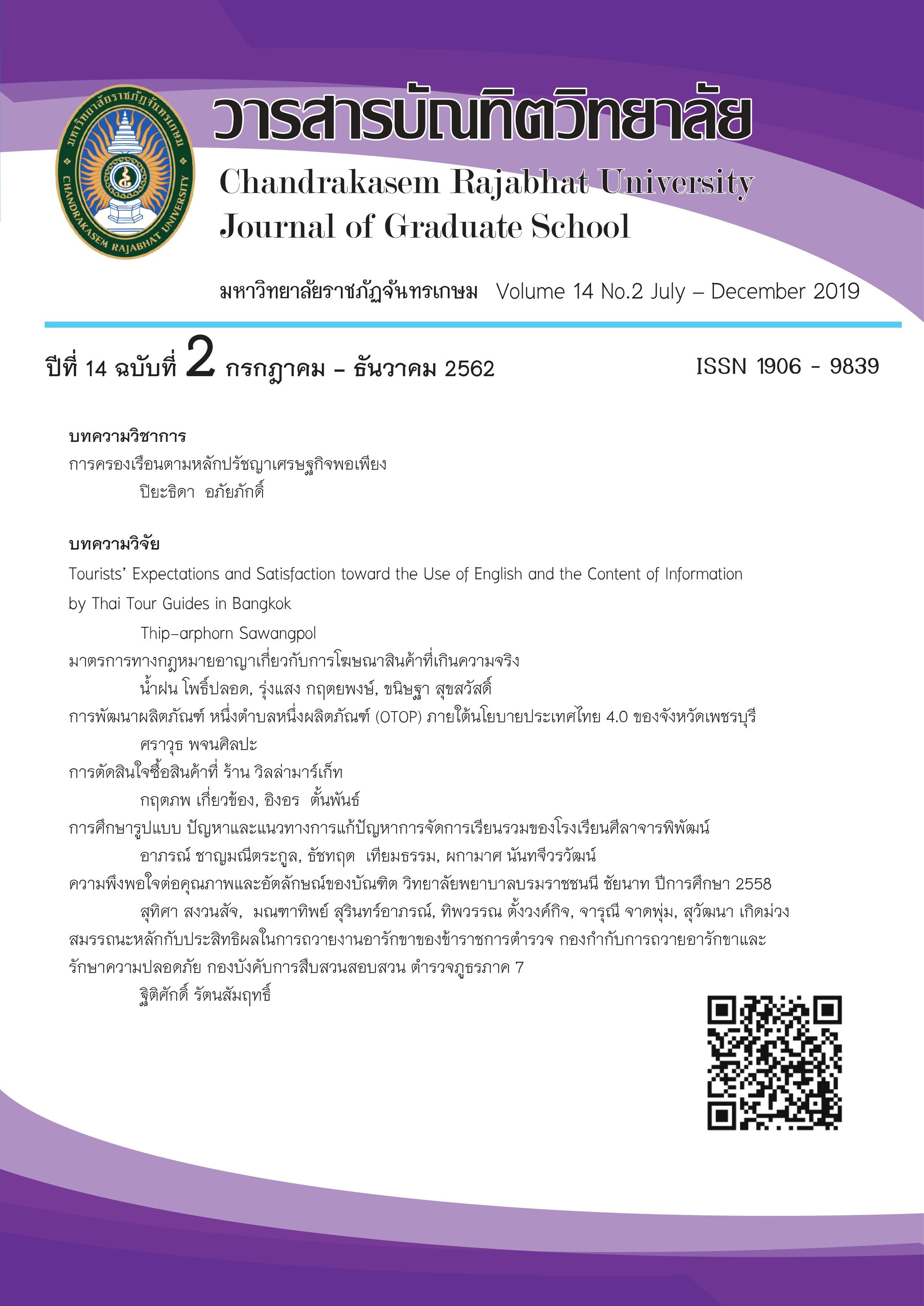ความพึงพอใจต่อคุณภาพและอัตลักษณ์ของบัณฑิต วิทยาลัยพยาบาลบรมราชชนนี ชัยนาท ปีการศึกษา 2558
Main Article Content
บทคัดย่อ
การวิจัยเชิงพรรณนานี้ มีวัตถุประสงค์เพื่อศึกษาความพึงพอใจต่อคุณภาพบัณฑิตและอัตลักษณ์ของบัณฑิตหลักสูตรพยาบาลศาสตรบัณฑิต วิทยาลัยพยาบาลบรมราชชนนี ชัยนาท ปีการศึกษา 2558 ประชากรคือผู้ใช้บัณฑิตพยาบาล จำนวน 143 คน เก็บรวบรวมข้อมูลโดยใช้แบบสอบถามประเภทให้ตอบด้วยตนเอง โดยส่งทางไปรษณีย์ไปยังผู้ใช้บัณฑิต จำนวน 143 ฉบับ และได้รับแบบสอบถามกลับคืนมาทั้งสิ้น 90 ฉบับ คิดอัตราการตอบแบบสอบถามกลับเท่ากับร้อยละ 62.94 วิเคราะห์ข้อมูลด้วยสถิติเชิงพรรณนา
ผลการศึกษา พบว่า ผลการประเมินความพึงพอใจของผู้ใช้บัณฑิตต่อคุณภาพบัณฑิตตามกรอบมาตรฐานคุณวุฒิระดับปริญญาตรีสาขาพยาบาลศาสตร์ ในภาพรวมทั้ง 6 ด้านอยู่ในระดับมาก (μ = 3.91, σ =0.60) ด้านที่มีค่าเฉลี่ยสูงสุดคือ ด้านคุณธรรม จริยธรรม (μ =4.15, σ =0.63) รองลงมาคือ ด้านความสัมพันธ์ระหว่างบุคคลและความรับผิดชอบ (μ =3.94, σ = 0.64) ด้านที่มีค่าเฉลี่ยต่ำสุดคือ ด้านทักษะทางปัญญา (μ =3.58, σ =0.53) สำหรับอัตลักษณ์ของบัณฑิต ในภาพรวมอยู่ในระดับมาก (μ = 3.87, σ =0.64) ด้านที่มีค่าเฉลี่ยสูงสุดคือ ด้านการให้บริการด้วยใจ (μ =4.17, σ =0.66) รองลงมาคือ ด้านการให้ผู้รับบริการมีส่วนร่วม (μ =3.91, σ =0.54) ด้านที่มีค่าเฉลี่ยต่ำสุดคือ ด้านการใช้ภูมิปัญญา (μ =3.64, σ =0.57) ผู้วิจัยมีข้อเสนอแนะว่าควรปรับวิธีการจัดการเรียนการสอน หรือกิจกรรมพัฒนาทักษะนักศึกษาโดยมุ่งเน้นให้คิดวิเคราะห์ เช่น การสอนแบบสอบสืบ การสอนแบบสร้างสรรค์ และบูรณาการการใช้ภูมิปัญญาในการจัดการเรียนการสอน
Article Details
เอกสารอ้างอิง
ประภาพรรณ เปลี่ยนแก้ว และเนาวนิจ พึ่งจันทรเดช. (2559). ความพึงพอใจของผู้ใช้บัณฑิตต่อสมรรถนะของบัณฑิตพยาบาล วิทยาลัยพยาบาลตำรวจ. วารสารพยาบาลตำรวจ, 8(1), 136-144.
วิทยาลัยพยาบาลบรมราชชนนี ชัยนาท. (2555). รายละเอียดของหลักสูตร (มคอ. 2) หลักสูตรพยาบาลศาสตรบัณฑิต (หลักสูตรปรับปรุง พ.ศ. 2555).
วิทวัส ดวงภุมเมศ, วารีรัตน์ แก้วอุไร. (2560). การจัดการเรียนรู้ในยุคไทยแลนด์ 4.0 ด้วยการเรียนรู้อย่างกระตือรือร้น. วารสารมนุษยศาสตร์และสังคมศาสตร์ บัณฑิตวิทยาลัย มหาวิทยาลัยราชภัฏพิบูลสงคราม, 11(2), 1-14.
ศุจิกา ภูมิโคกรักษ์, อัจฉรา สุคนธสรรพ์, อัญญารัตน์ ว่องวิริยะพันธุ์, ธันยาภรณ์ เหลี่ยวตระกูล, วัชรี นาคะป่า (2559). คุณลักษณะของบัณพิตที่พึงประสงค์ตามมุมมองของผู้ใช้บัณฑิตคณะพยาบาลศาสตร์ มหาวิทยาลัยเชียงใหม่. พยาบาลสาร, 13(ฉบับพิเศษ),151-161.
สายสวาท เผ่าพงษ์, จุฑาทิพย์ ศิรินภาดล, สิริเพ็ญโสภา จันทรสถาพร, ภิรมย์ลักษณ์ มีสัตยานันท์.(2555). อัตลักษณ์บัณฑิต วิทยาลัยพยาบาลบรมราชชนนี นครราชสีมา. วารสารวิทยาลัยพยาบาลบรมราชชนนี นครราชสีมา, 18(1), 5-16.
สุภัชฌาน์ ศรีเอี่ยม. (2553). อัตลักษณ์นิสิตนักศึกษาในสถาบันอุดมศึกษา. วารสารวิชาการมหาวิทยาลัยอีสเทิร์นเอเซีย, 2(2), 186-199.
สำนักงานคณะกรรมการการศึกษาแห่งชาติ. (2545). พระราชบัญญัติการศึกษาแห่งชาติ พ.ศ. 2542 และที่แก้ไขเพิ่มเติมฉบับที่ 2 พ.ศ. 2553. กรุงเทพฯ: พริกหวานกราฟฟิค จำกัด.
สำนักงานคณะกรรมการการอุดมศึกษา กระทรวงศึกษาธิการ. (2557). คู่มือการประกันคุณภาพการศึกษาภายในระดับอุดมศึกษา พ.ศ. 2557 (พิมพ์ครั้งที่ 4). กรุงเทพฯ: ภาพพิมพ์.
อรนันท์ หาญยุทธ, รัชยา รัตนะถาวร. (2556). คุณภาพและอัตลักษณ์ของบัณฑิตคณะพยาบาลศาสตร์ มหาวิทยาลัยอีสเทิร์นเอเชียที่สำเร็จการศึกษา ปีการศึกษา 2553. วารสารวิชาการมหาวิทยาลัยอีสเทิร์นเอเชีย,7(2), 99-107.
อรุณี อูปแก้ว, ประภัสสร วงษ์ศรี, ภควรรณ สมบูรณ์, สุภาพร ประนัดทา. (2558). ความพึงพอใจของผู้ใช้บัณฑิตหลักสูตรพยาบาลศาสตรบัณฑิต. วารสารพยาบาลศาสตร์, 33(ฉบับพิเศษ1): 77-84.
Best, J.W. (1977). Research in Education: Englewood Cliffs, New Jersey: Prentice-Hall Inc.
Salkind, N.J. (1977). Exploring research (3rd ed.). Upper Saddle River, NJ: Prentice Hall.
Trilling, B., Fade,l C. (2009). Learning and innovation skills: 21st century skills learning for life in our times. San Francisco: Jossey-Bass.


